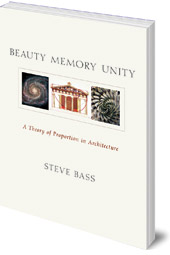Beauty, Memory, Unity
A Theory of Proportion in Architecture
Quick Look
- Argues for a return to the use of proportion in the visual arts
- Examines the history of architecture, from ancient civilisations through the Renaissance and the Enlightenment
- By an experienced architect who studied at the Royal College of Art, London, under Keith Critchlow
Examining the sense of unity and harmony in architecture, and calling for a return to the use of proportion, this book ranges impressively from ancient Egypt, Greece and Rome to the Middle Ages, the Renaissance and the Enlightment.
Description
Ancient architects and artists had a way of striking resonant chords in the viewers of their work. This book points to a possible way of returning a sense of unity to the visual arts through a combination of theoretical ideas and practical methods, of narrative description and visual exercises.
Proportion, the use of number and geometry as design tools, is seen in the context of the search for the beautiful. From the theoretic, symbolic mathematics of the Pythagoreans, Platonists, and Neo-Platonists, the book proposes an aesthetic theory, a way of approaching beauty, rooted in the idea of psyche and expressed through the ancient sciences of arithmetic, geometry, music, and astronomy.
Topics treated include: an explanation of the concept of symbolic or qualitative number; an introduction to Pythagorean and Platonic numerical philosophy; the nature of beauty and its relation to number; the derivation of the ancient musical octave; the Golden Section, its mathematics, geometry, and relation to philosophy, particularly its role as a geometrical logos; and the connection of these ideas to the numerical-geometrical canons of classical architecture. These concepts are illustrated step by step as applied to the elements and archetypal compositions of classical architecture, such as the order and portico, using arithmetic, geometric, and harmonic ratio methods.
The proportional idea is illustrated with reconstructions of exemplary buildings based on the methods described, following through the historical periods of Egypt, Greece, Rome, the Middle ages, the Italian Renaissance, and the Enlightenment.
Though the book is focused on architecture, the methods presented may be used by artists and designers in any visual field. The book suggests several pathways on which contemporary designers might move toward creating a sane and beautiful world through a merger of art and science.
Author
Steve Bass was born in 1947 in Brooklyn, New York. He studied architecture at the Pratt Institute and the Royal College of Art, London, where he studied under Keith Critchlow. He is a Fellow of the Institute of Classical Architecture and Art in New York, where he teaches on a variety of classical subjects.

